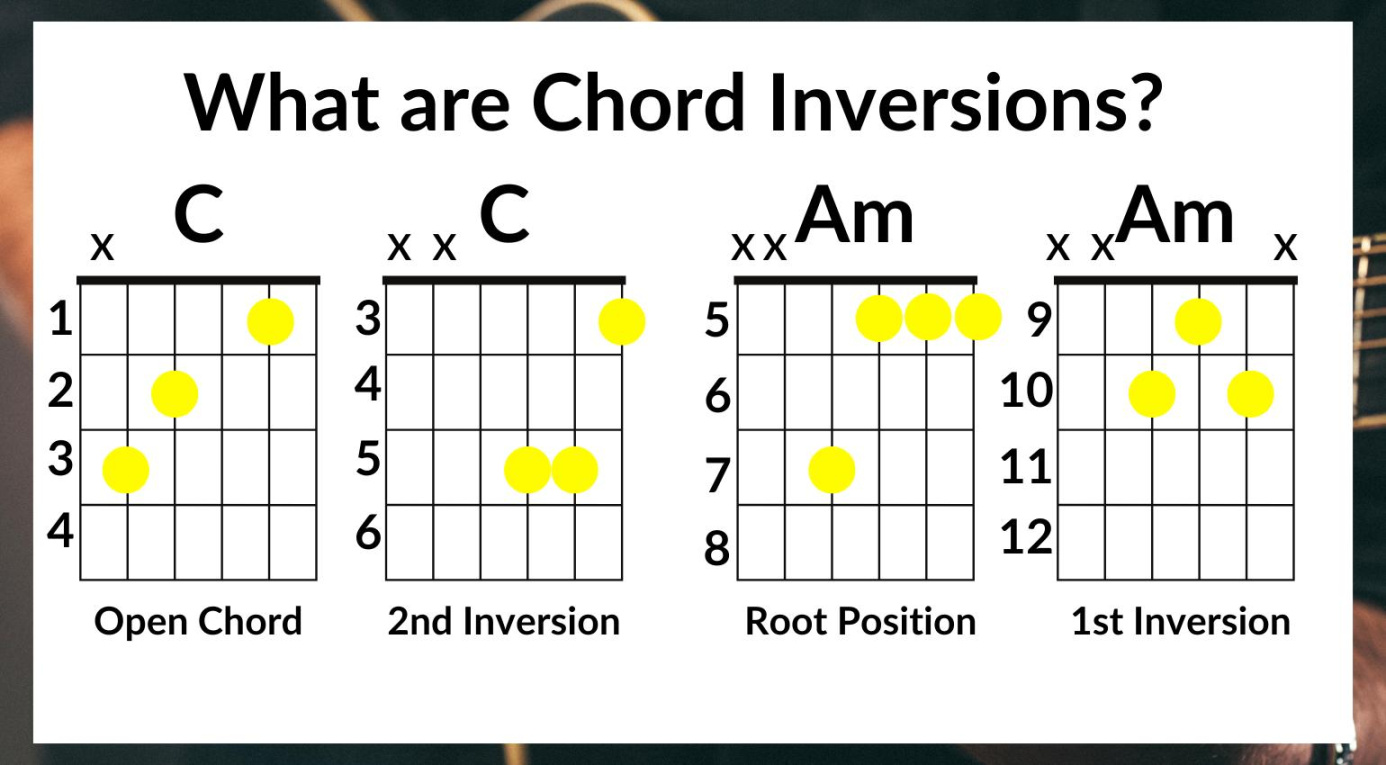Guitar Chord Inversions: Flipping Your Chords for Sweet Sounds
So, you’re strumming away, learning chords, and you’ve got your basics down. You know your C, G, D, and all that jazz. But have you ever noticed how sometimes, a chord just sounds a little… different? Maybe it’s smoother, or it fits better in a certain spot of a song. That’s where chord inversions come in. They’re like the secret sauce for making your guitar playing sound way more interesting and professional.
Think of a chord like a pizza. You’ve got your main ingredients, right? But you can arrange those ingredients in different ways and still have pizza. That’s kind of what inversions do with chords. We’re not changing the notes themselves, just the order they appear in.
What Are Inversions Anyway?

Basically, a chord inversion is when you take the notes of a chord and rearrange them so that a different note is at the bottom. The note at the bottom is called the bass note. Let’s take a C major chord as an example:
C Major Chord: Normally, a C major chord is made up of the notes C, E, and G. C is the root of the chord, so when C is the lowest note, it’s called the root position.
Why bother with this? Well, it can make a huge difference in how your chords sound and how they connect to each other.
Why Use Chord Inversions?
There are a few solid reasons why guitarists use inversions:
Smoother Transitions
Imagine you’re playing a chord progression. If you keep all the chords in their root positions, sometimes you’ll have big jumps between the bass notes. That can sound a little clunky. But if you use inversions, you can create smoother transitions, making your playing sound more fluid.
Better Bass Lines
Inversions allow you to create more interesting bass lines. Instead of just jumping from one root note to another, you can have a more melodic bass line that connects the chords together. This is especially useful when playing with other musicians or when you’re trying to create a more sophisticated sound.
Different Voicings
Each inversion has a slightly different voicing, which means the notes are arranged in a way that gives the chord a unique sound. Some inversions sound brighter, while others sound warmer or more mellow. This can add a lot of variety to your playing.
Playing Higher Up The Neck
Sometimes, the root position of a chord might be too low or too difficult to play in a certain part of a song. By using inversions, you can often find a more comfortable way to play the chord higher up the neck.
How To Find Inversions On The Guitar
Finding inversions on the guitar can take a little practice, but it’s not as hard as it might seem. Here’s a basic approach:
Learn Your Chord Shapes
Start by getting comfortable with the basic shapes of your major and minor chords. Once you know these shapes, you can start to experiment with moving the notes around.
Identify The Root, Third, And Fifth
Remember that every major and minor chord is made up of three notes: the root, the third, and the fifth. Knowing which note is which in your chord shapes is crucial for finding inversions.
Move The Notes Around
To find the first inversion, move the root note up an octave. To find the second inversion, move the third note up an octave. Experiment with different fingerings until you find a comfortable way to play the inversions.
Use Your Ears
Don’t just rely on theory. Use your ears to listen to how the different inversions sound. Pay attention to how they connect to the other chords in your progression.
Common Chord Inversions and Examples
Let’s look at a few examples of common chord inversions:
C Major Inversions
Root Position: C-E-G
G Major Inversions
Root Position: G-B-D
A Minor Inversions
Root Position: A-C-E
You’ll find that by applying this simple concept to all chords, your playing will improve dramatically.
Practical Applications
Where can you put this knowledge to use?
Writing Chord Progressions
When writing your own songs, inversions are your best friend. They can help you create more interesting and melodic chord progressions.
Playing With A Bass Player
If you’re playing with a bass player, using inversions can help you complement their playing and create a more cohesive sound.
Solo Guitar Playing
Even if you’re playing solo, inversions can add a lot of depth and complexity to your playing.
Jazz and Blues
In genres like jazz and blues, inversions are essential for creating the sophisticated harmonies that these styles are known for.
Conclusion
Chord inversions might seem a little intimidating at first, but they’re really just a simple way to add some extra flavor to your guitar playing. By understanding how they work and experimenting with different inversions, you can create smoother transitions, more interesting bass lines, and a wider range of voicings. Don’t be afraid to experiment, and most importantly, use your ears. You’ll soon discover how inversions can take your guitar playing to a whole new level. They’re a valuable tool in any guitarist’s arsenal, allowing for greater musicality and creativity. So, go ahead, flip those chords around, and see what you can create!

